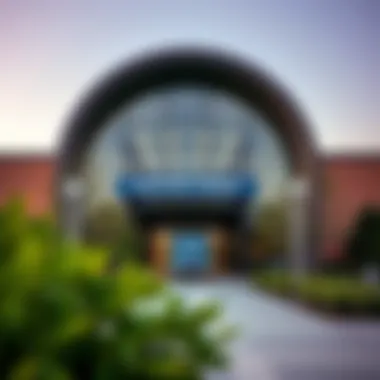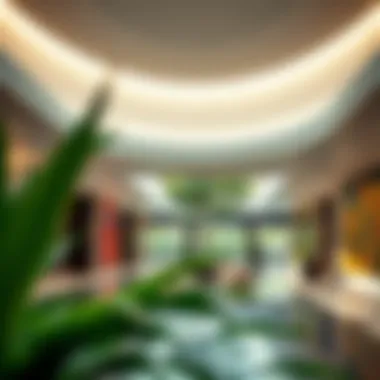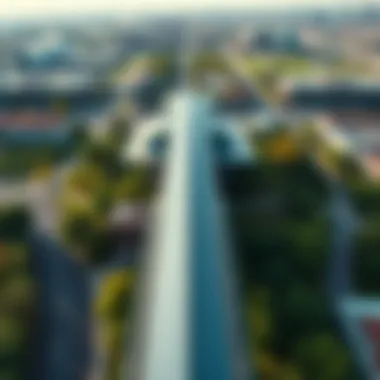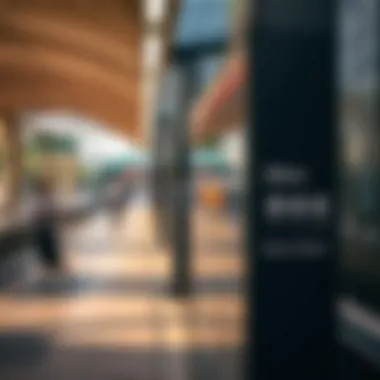The Garden Metro Station: Urban Transit and Design Excellence


Intro
In the heart of Dubai, the Garden Metro Station is more than just a stop on a transportation line; it's a symbol of modern urban design and a catalyst for economic growth. It serves as a crucial junction for both residents and visitors, making it a focal point within the city’s extensive public transport network. The station exemplifies how architecture can harmonize function and aesthetics while also giving a push to sustainable transport initiatives, a critical need in today's rapidly evolving urban landscapes.
This narrative seeks to unfold the many layers of the Garden Metro Station, discussing its architectural beauty alongside its operational significance. As we delve into the station's surroundings, we will also touch upon the various investment opportunities it has garnered, shaping the future of real estate in Dubai.
Market Trends
Current Market Analysis
The real estate market around the Garden Metro Station showcases a dynamic interplay between urban transit and development. Areas surrounding this transport hub have witnessed a surge in property values, driven by both commercial and residential investments. The introduction of efficient metro services often attracts business establishments and creates residential demand, leading to more people wanting to live near accessible transportation options.
- Rental Growth: Properties near the Garden Metro Station have seen an increase in rental prices as demand rises among young professionals and families seeking easy access to work and leisure.
- Commercial Viability: Retail spaces and offices in the vicinity benefit from the foot traffic that the station brings, enhancing their attractiveness to businesses.
Future Projections
Looking ahead, market analysts are optimistic about the ongoing development of the surrounding neighborhoods. With Dubai's urban infrastructure continuously evolving, the Garden Metro Station is positioned to play a significant role in shaping future transit-oriented development.
- Continued Investment: Anticipated increases in local and foreign investment are likely as developers identify the potential for mixed-use developments, which combine residential, commercial, and retail spaces in a single location.
- Sustainable Initiatives: As more focus is placed on sustainable urban living, projects that prioritize green building practices are expected to gain traction near the station.
"The Garden Metro Station is not just a transit point; it’s the heart of an emerging investment landscape."
Investment Strategies
Best Neighborhoods to Invest In
Navigating the investment terrain around the Garden Metro Station can be overwhelming, but certain neighborhoods stand out as particularly compelling for real estate investment.
- Al Rigga: Close to the station, this neighborhood offers a mix of residential options with commercial viability, ideal for buyers seeking both living and business opportunities.
- Deira: Known for its rich history, Deira is seeing a resurgence due to its close proximity to public transit, making it attractive for those seeking both heritage and modernity.
Tips for First-Time Investors
For those venturing into the real estate market for the first time around the Garden Metro Station, the following strategies can provide a solid foundation:
- Research Your Options: Understanding the market trends and local dynamics will help in making informed decisions.
- Networking: Build relationships with local real estate agents who can provide insight into the best deals.
- Monitor Development Plans: Keep an eye on city projects and future plans for the area; upcoming improvements can dramatically affect property values.
As we unravel the nuances embedded within the Garden Metro Station and its vicinity, it becomes clear that the fusion of transit and architecture is not merely about mobility but is about creating thriving communities and robust investment opportunities.
Intro to the Garden Metro Station
The Garden Metro Station serves as more than just a stop along Dubai's bustling rail network. It stands as a critical junction between urban mobility, architectural sophistication, and community interaction. Designed thoughtfully, this station enhances the commuting experience, making it not only efficient but also pleasant. Its presence has broad implications for urban planning and socio-economic growth in the region.
Historical Context
To understand the significance of the Garden Metro Station, one has to take a step back into the annals of Dubai's transit history. The inception of the Dubai Metro in the early 2000s marked a turning point in how residents and visitors navigated the rapidly growing city. As the city expanded at breakneck speed, it became clear that alternatives to driving were essential. The Garden Metro Station came into the picture as part of a larger vision aimed at reducing traffic congestion and encouraging sustainable urban living.
Historically, the area surrounding the station had transitioned from traditional marketplaces into a modern urban landscape that now buzzes with commercial activity. This transition signifies the social fabric of the city, where new developments knotted with old ones create a unique and vibrant community identity. As such, the Garden Metro Station functions not merely as a transit point, but as a historical marker of Dubai's urban evolution and its aspirations toward becoming a global city.
Purpose and Functionality
Delving into the purpose and functionality of the Garden Metro Station reveals layers of thought behind its design. This station caters to a diverse array of commuters, including tourists exploring the city's attractions and residents going about their daily routines. It’s a crucial point in the metro system connecting multiple key locations like malls, parks, and business districts.
Functionally, the station is designed to accommodate high passenger volumes efficiently. Commuters enjoy advanced features like real-time information displays, accessible platforms, and seamless integration with other forms of public transport, enhancing travel convenience. Its layout is geared toward optimizing passenger flow, which is vital during peak hours, ensuring that the station operates smoothly even when foot traffic is at its busiest.
Furthermore, the strategic location of the Garden Metro Station reinforces its purpose in enhancing the overall efficiency of Dubai's transit network. By acting as a bridge between different metro lines and bus services, it encourages public transport usage, steering away from individual vehicular reliance, which is paramount for sustainability in urban growth.
"The Garden Metro Station is not just about transit; it represents a lifestyle choice for sustainability and connectivity in a modern city like Dubai."
As such, the Garden Metro Station embodies both historical significance and future-oriented thinking. Its role as a dynamic and functional transit hub aligns with broader objectives of urban mobility, making it integral to Dubai's ongoing development.
Architectural Design


Architectural design plays a pivotal role in shaping the character and efficiency of public infrastructure like the Garden Metro Station. It goes beyond aesthetics; the design must cater to functionality, environmental impact, and user experience. In the case of the Garden Metro Station, thoughtful architectural decisions enhance both its visual appeal and operational effectiveness, underscoring how such elements can harmonize in an urban context.
Exterior Features
The exterior of the Garden Metro Station is a true showcase of modern architectural trends that marry form with function.
Materials Used
When discussing the materials used in constructing the Garden Metro Station, it's essential to highlight the choice of glass and steel. These materials not only contribute to the striking visual identity of the station but also serve practical purposes like durability and maintenance ease. Glass offers natural lighting which brightens interior spaces, while steel provides structural strength. This combination is a popular choice in contemporary architectural projects, as it links the building to its modernity without compromising on historical context.
One unique feature of the structural glass is its ability to change appearance based on weather conditions. On sunny days, the reflection of light gives the building a shimmering quality, which can be less pronounced during overcast times. This dynamic characteristic makes the station visually appealing across different contexts. However, the potential downside involves potential glare issues for passengers waiting at the platform or entering the station.
Design Innovations
In addition to unique materials, the Garden Metro Station showcases a range of design innovations that set it apart from typical transit hubs. One notable innovation is the incorporation of solar panels integrated into the roof design. This not only supports energy efficiency but also aligns with Dubai’s initiative for sustainable energy resources. The design pushes the envelope by adopting a green infrastructure ethos, making it a beneficial model to follow for urban planners.
The design's organic curves and open spaces are crafted to create a seamless flow for passengers navigating between platforms or properties nearby. This layout reduces congestion and enhances the commuter experience. One limiting factor, however, is that while these design elements maximize open space, they may not fully utilise every square foot effectively, which could be debated among urban planners for future projects.
Interior Layout
The interior layout is where the Garden Metro Station truly excels in facilitating passenger movement and comfort. The design prioritizes both functionality and aesthetic pleasure, making it a pleasant environment for commuters.
Passenger Flow Considerations
Efficient passenger flow is at the heart of the station's design considerations. The open layout features wide corridors and strategic placement of entry and exit points, allowing for a natural traffic flow that prevents bottlenecks. Signage is clear and intuitive, guiding passengers quickly to various lines and exits which is crucial, especially during peak hours when foot traffic spikes. Integrating these features minimizes confusion and enhances the overall travel experience. One downside could be the complexity added for less familiar users, who may still struggle with orientation despite navigational aids.
Accessibility Features
Accessibility is another critical focus area that separates truly modern metro stations from their predecessors. The Garden Metro Station has incorporated features like tactile pathways for the visually impaired, elevators, and ramps that comply with international standards, ensuring inclusivity for all passengers. This aspect of design reflects a broader commitment to provide equitable access to public transportation.
The station prides itself on using multi-sensory cues to assist all users, making it easier for diverse populations to navigate. However, ongoing maintenance of these features can be a challenge. Keeping elevators operational and ensuring tactile paths remain unobstructed can be demanding, but they are essential for the integrity of the overall design.
In summary, the architectural design of the Garden Metro Station embodies a robust vision for urban transit that considers aesthetic appeal, functionality, and inclusivity. Each design aspect contributes to not only a beautiful structure but a practical transport hub, vital for the city’s continuous urban evolution.
Operational Significance
Understanding the operational significance of the Garden Metro Station is key to appreciating its role within the larger framework of Dubai’s transportation network. This section examines its contributions to the metro system while also looking at how these operations affect commuter behavior and overall urban mobility. By scrutinizing various elements such as connectivity, service frequency, and the demographics of its user base, we can glean a deeper understanding of why this station is pivotal for the city’s transit infrastructure.
Role in the Metro Network
Connecting Key Areas
One of the standout features of the Garden Metro Station is its effectiveness in connecting crucial landscapes within Dubai. Positioned strategically, this station links residential, commercial, and tourism hotspots, allowing seamless travel across different sectors of the city. Imagine the ease with which you could travel from the sprawling malls to relaxing parks and vibrant business centers. This interconnectivity is not just a convenience; it is a boon for urban planners and investors alike. It enhances overall accessibility, fostering an environment where people are more willing to explore and engage with the space around them.
The unique placement of the station provides a reliable transit route, enabling commuters to venture into areas that may have previously been less accessible. For residents, this connection can translate into better job opportunities and lifestyle choices, while for businesses it opens avenues to a larger customer base. Yet, it is essential to consider the potential drawbacks as well, such as the influx of commuters leading to overcrowding during peak hours.
Frequency of Services
Equally important is the frequency of services provided by the Garden Metro Station. Offering regular, timely service caters to a diverse range of users, particularly those with demanding schedules. The station’s key characteristic is its ability to maintain high operational efficiency, ensuring that trains frequently arrive and depart. This reliability is a significant draw for commuters, encouraging more people to choose public transit over personal vehicles.
Factors like rush-hour services operate at intervals that allow for quick boarding and unloading. However, there’s a flip side; such a high frequency can sometimes lead to increased operational costs and require diligent coordination among transit authorities. Balancing service demand with efficient management is crucial for the station’s success.
Impact on Commuter Behavior
User Demographics
The user demographics at the Garden Metro Station paint a vivid picture of diverse commuters, ranging from locals to international tourists. Understanding who uses the station helps discern the larger trends influencing Dubai’s transit landscape. Many are young professionals and families who rely on accessibility and efficiency in their daily commutes.
What sets this place apart is how it draws a blend of users—residents living nearby and tourists seeking exploration. This variety bolsters a vibrant atmosphere but it also requires tailored services to meet their differing needs. For instance, tourists may favor information kiosks and language support, whereas regular commuters might prioritize swift transit and reliable service hours.
Travel Patterns
Travel patterns linked to the Garden Metro Station reveal insights into commuter flow, preferences, and lifestyle choices. Many individuals choose to utilize the metro for its time-saving qualities, highlighting its influence on overall travel behavior across the city. Peak hours often see an increase in service utilization, which underscores the importance of efficient scheduling.


The unique feature of these travel patterns is their adaptability; as seasonal changes occur, such as during festivals or holidays, traffic trends shift significantly, creating a dynamic environment for transit operators. This variability underscores the necessity for ongoing analysis and adjustment in service provisions to meet the city’s evolving demands.
To conclude this section, the operational significance of the Garden Metro Station cannot be overstated. It is more than just a transit point; it is a lifeline that supports the fabric of Dubai’s urban living. By connecting key areas, ensuring frequency of services, and shaping commuter habits, the station remains integral to the city’s transportation narrative.
Surrounding Development
The surroundings of the Garden Metro Station not only enhance its beauty but also foster economic prospects that ripple across the wider district. The integration of this transit hub within a thriving urban landscape serves as a catalyst for transformation—a nexus that sparks high-interest in property investments and elevates commercial vitality. It’s a recipe for urban success; proximity to a metro station generally elevates the appeal of nearby areas, adding layers of convenience and lifestyle that are hard to resist.
Real Estate Trends
Property Values
Property values around the Garden Metro Station have experienced noteworthy fluctuations, resonating well with both residential and commercial real estate. The station's very presence elevates real estate desirability, as it establishes a connection to key areas within Dubai. When metro users can hop on and off with ease, they’re more inclined to seek nearby living options or consider properties within a short commute.
For instance, developments such as Al Barsha Heights have seen significant demand increases, with statistics reflecting a 15% rise in property values since the station's inauguration. This surge isn’t just because of the appealing architecture but the consistent connectivity provided for daily commuters.
However, potential investors must remain vigilant; property values can also fluctuate based on market conditions—like any other real estate venture, the landscape has its ups and downs. But overall, the proximity to a transportation hub generally points towards a positive trajectory, consolidating the area’s reputation as a beneficial investment choice.
Investment Opportunities
Investment opportunities near the Garden Metro Station are ripe for exploration. With urban mobility at the heart of development plans, investors find that high-density residential projects and smart business solutions are gaining traction. The area is becoming a bustling marketplace, with new ventures sprouting up to cater to the growing population of commuters and residents alike.
Key features include activations like community markets, pop-up shops, and trendy cafes that jump into the retail landscape with inviting flair. These establishments not only capture foot traffic but can also contribute positively towards sustained rental income.
On the flip side, there’s a need for astute observation; while the initial costs of real estate investment may seem steep, the long-term benefits often outweigh the hurdles. Investors might find themselves navigating fluctuating rental rates, but the demand for prime locations close to efficient transport links makes a compelling case for continued investment.
Commercial Impact
Transformative echoes of the Garden Metro Station can be heard in the commercial sphere as well, where businesses capitalize on the influx of foot traffic and consumer interaction resulting from enhanced public transportation.
Retail Spaces
Retail spaces sprouting up around the station represent a vibrant commercial atmosphere. Shops, eateries, and jazzy boutiques all vie for attention from those passing through, creating a lively economic ecosystem. This dynamic ensures that businesses cater to a diversified clientele, from busy professionals needing quick bites to shoppers taking leisurely strolls after work.
Notably, establishments like the Garden Mall offer not just shopping but also an experience, enticing visitors with a repeat destination. The harmonious blend of convenience and atmosphere plays a key role in propelling these retail formats to thrive, making them a popular choice for new ventures in Dubai.
Business Amenities
The business landscape surrounding the Garden Metro Station has been bolstered by an abundance of amenities catered specifically for working professionals. Co-working spaces, business lounges, and conference centers pave the way for companies to establish themselves in high-impact areas.
These spaces typically provide flexible leasing options and essential services that suit startups and established firms alike. A spot such as WeWork not only provides office spaces but cultivates a community that thrives on collaboration—a trend that has become increasingly popular in our digital age.
However, it’s crucial to analyze the varying pace of establishment and increase in demand; while some businesses flourish through strategic location, others might take longer to draw in clientele. Keeping abreast of market trends is vital for anyone considering venturing into this commercial landscape.
Sustainable Transportation
Sustainable transportation emerges as a focal point in discussions about urban mobility, particularly regarding the Garden Metro Station. This concept embodies more than just the mechanics of getting from point A to point B. It encompasses environmental stewardship, efficient resource utilization, and enhancing community connectivity. These elements combined not only improve the life quality of residents but also cater to the growing tourist influx in Dubai, making public transit a linchpin in urban development.
Environmental Considerations
Energy Efficiency
Energy efficiency stands at the forefront of sustainable transport initiatives. In the context of the Garden Metro Station, this can be observed in its energy systems and infrastructure design. Utilizing energy-efficient technologies means the station consumes less power compared to traditional models, directly impacting operating costs and reducing long-term environmental impact.
One specific feature that enhances this energy efficiency is the installation of LED lighting throughout the station. Unlike conventional lighting, LED technology offers a prolonged lifespan and lower energy consumption. This choice not only conserves energy but has also been increasingly adopted in modern public infrastructures, making it a popular option in urban settings.
Yet, the main advantage lies in savings on utility bills. These savings can fund further improvements or maintenance, thus providing an economic boost while promoting environmental responsibility in energy management. However, an initial investment in these technologies might deter some from making the switch.
Carbon Footprint Reduction
Carbon footprint reduction is another crucial aspect linked to sustainable transportation. The aim here is to decrease greenhouse gas emissions associated with commuting. Given that the Garden Metro Station serves thousands of passengers daily, its influence on the region’s carbon output can be significant.
A notable feature of this reduction strategy is the integration of electric trains. These modern trains release virtually no emissions during operation, which contributes greatly to lowering the overall carbon footprint of public transit. This strategy not only benefits the environment but also aligns with global efforts to combat climate change, making it a sensible and appealing characteristic for urban planners and the public alike.


The continuous shift towards greener technologies in public transport acts as a catalyst for wider systemic transformations, positively impacting urban air quality. However, potential drawbacks include the upfront capital needed to implement these technologies, which might be daunting for local budgets and financial plans.
Promoting Public Transit
Encouraging Use of Public Transport
Encouraging the use of public transport is essential for minimizing traffic congestion and promoting a more organized urban landscape. The Garden Metro Station plays a pivotal role in this endeavor by offering reliable services and convenient access points throughout Dubai.
A standout characteristic is the user-friendly interface of the station, including well-marked routes and schedules, making it easier for newcomers to navigate the transit system. This feature not only attracts regular commuters but also piques the interest of tourists exploring the city.
One key advantage is the potential to significantly reduce the number of personal vehicles on the road, thereby lessening pollution levels and improving air quality. However, there may be resistance from individuals who are accustomed to the comfort and privacy of driving. Addressing this mindset requires strategic marketing campaigns highlighting the benefits of public transport.
Integration with Other Modes
Integration with other modes of transport is essential for a seamless travel experience. The Garden Metro Station is strategically located to facilitate easy transfers between buses, taxis, and even bicycle-sharing systems. This interconnectedness is what makes public transport a truly viable alternative.
A characteristic feature of this integration is the dedicated transport hubs, which serve as melting pots of mobility options. For instance, having multiple transportation choices converge at one location ensures that passengers can transfer effortlessly without the stress of time constraints or confusing transitions. Such a feature proves beneficial not just for the daily commuter but also for businesses reliant on foot traffic from connected transport options.
While the advantages of such integrated systems are numerous, maintaining schedules across different transport modes can present challenges. Coordination requires robust systems and technology to keep everything in sync. Additionally, ensuring a smooth experience is paramount, as any hiccup can deter potential users of the public transport network.
By leveraging sustainable practices and embracing integrated transport solutions, the Garden Metro Station stands as a beacon for what the future of urban transit can look like. This both minimizes environmental impact and fosters a culture of responsible commuting among residents and visitors alike.
Future Prospects
Looking ahead, the potential for the Garden Metro Station is nothing short of promising. As a keystone in Dubai's public transportation network, its future prospects are intertwined with various elements that can benefit residents, commuters, and investors alike. The integration of this station into the broader fabric of urban expansion and the push towards sustainable transport solutions makes it a vital point of focus. It holds significant implications not just for daily commuters but also for urban developers and businesses who thrive on the evolving landscape of Dubai.
Proposed Expansions
With the pace of development in Dubai, there are plans to enhance the Garden Metro Station further, ensuring that it meets the growing demands of the public. Proposed expansions may include:
- Additional platforms to accommodate increasing passenger volumes as the city continues to attract new residents.
- Integration with other transit systems, including bus routes and cycling lanes, providing seamless connectivity.
- Upgrades in technology, such as mobile apps for real-time train tracking and smart ticketing systems that make commuting smoother.
These expansions are essential not only for improving commuter experience but also for boosting the station's functionality as a key transit hub.
Long-term Urban Planning Goals
In the grander scheme of things, the future of the Garden Metro Station is connected to long-term urban planning goals laid out by local government entities. As Dubai aims for a more sustainable and interconnected city, it has set ambitious plans that involve:
- Sustainable urban development, focusing on creating eco-friendly infrastructure that works in harmony with nature.
- Zoning regulations that promote mixed-use developments surrounding the station, allowing residential, retail, and commercial spaces to coexist, which in turn can lead to increased property values.
- Community engagement initiatives that encourage public input on transport planning, ensuring that the station meets the needs of diverse groups.
In summary, these goals signal a proactive approach to urban transit that goes beyond just expansions. They emphasize a cohesive, forward-thinking strategy that weaves together transportation, sustainability, and community growth, making the Garden Metro Station a pivotal player in shaping the urban landscape of Dubai.
The Garden Metro Station is not merely a stop on the transit map; it is a dynamic cornerstone poised for growth and development in an ever-evolving city.
Epilogue
The Garden Metro Station is more than just a transit hub; it is a pivotal element that influences the broader urban landscape of Dubai. It is essential to reflect on how this station not only serves its immediate purpose for commuters but how it weaves itself into the very fabric of the city.
Reflection on the Garden Metro Station's Role
The role of the Garden Metro Station transcends its immediate functionality. This station embodies a commitment to sustainable urban planning and architectural elegance. It connects different neighborhoods and business districts, making it a lifeline for residents and visitors alike.
Through its well-thought-out design, including accessibility features that cater to all users, the station is shaping commuter behavior. People are more likely to utilize public transport when it is efficient and user-friendly. This shift encourages a reduction in vehicle use, contributing positively to the environment. In essence, the Garden Metro Station symbolizes progress and modernization in Dubai's transportation narrative.
"Infrastructure can define urban legacies, and the Garden Metro Station stands testament to Dubai’s vision for a seamless urban experience."
Imagine the daily lives of thousands who rely on this space. From professionals heading to work to tourists exploring the attractions nearby, the station functions as a meeting point of cultures and ambitions. Further, its location is strategically chosen to stimulate local economies. The increased foot traffic leads to greater visibility for nearby retail businesses and dining establishments, creating an ecosystem where everyone benefits.
Future Implications for Dubai's Transit System
As we gaze into the future, the implications for Dubai's transit system are profound. Urban planners envision a seamless connectivity that integrates new metro lines and bus routes expanding capacity and reducing congestion. The Garden Metro Station is likely to play a crucial role in this expansion.
Consider these points:
- Proposed enhancements: Increasing capacity to handle higher commuter volumes as the city grows. This will require careful planning to maintain service quality.
- Integration with technology: Smart ticketing solutions could streamline the commuting experience further, making travel simpler for users.
- Sustainability initiatives: Continued investments in green technology, such as solar-powered energy for facilities, could reinforce the station’s commitment to eco-friendly practices.
Investors and urban developers should note how the Garden Metro Station could be a fulcrum for future projects. The anticipating vitality in surrounding real estate markets is a signal of robust demand. As the city evolves, so will the opportunities tied to this significant transit hub. Whether for leisure, commerce, or connectivity, all roads seem to converge at the Garden Metro Station, preparing its users for the vibrant future of Dubai's transit systems.
In summary, the Garden Metro Station is a cornerstone of urban life in Dubai, and its evolution will undoubtedly shape the city’s trajectory for years to come. Investors, real estate agents, and market analysts should keep their eyes peeled as this narrative unfolds.











